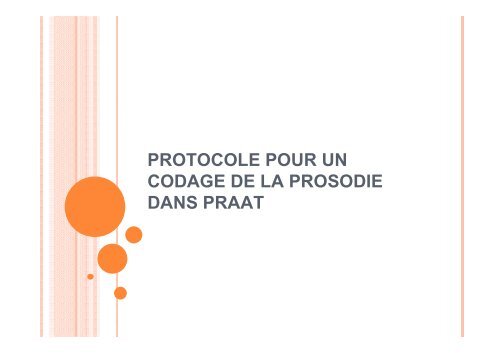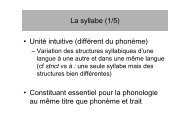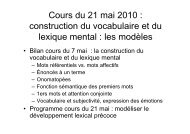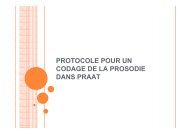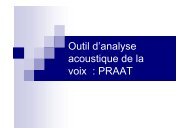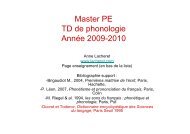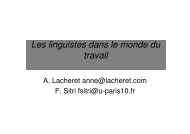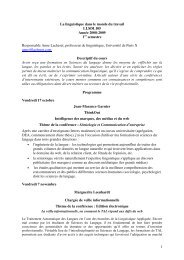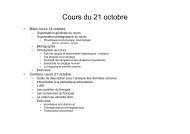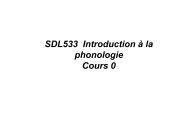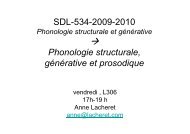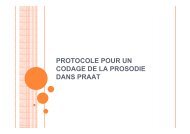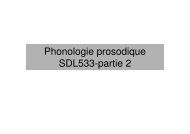protocole pour un codage de la prosodie dans praat - Anne Lacheret
protocole pour un codage de la prosodie dans praat - Anne Lacheret
protocole pour un codage de la prosodie dans praat - Anne Lacheret
- No tags were found...
You also want an ePaper? Increase the reach of your titles
YUMPU automatically turns print PDFs into web optimized ePapers that Google loves.
PROTOCOLE POUR UNCODAGE DE LA PROSODIEDANS PRAAT
Séance 1: 18 novembre
INTRODUCTION ObjectifsPrise en main <strong>de</strong> PraatPrésentation du <strong>protocole</strong> <strong>de</strong> <strong>codage</strong>Entraînement sur <strong>de</strong>s extraits <strong>de</strong> corpus tout-venants
A1PRAAT Logiciel d’analyse acoustique du son Gratuit, amélioré en permanence, Praat <strong>de</strong>vient <strong>la</strong> référence. Il est étayé d'<strong>un</strong> site web trèscomplet avec forum (http://www.<strong>praat</strong>.org) Très grand nombre <strong>de</strong> fonctionnalités et son utilisation reste très intuitive et facile malgré<strong>un</strong> aspect (peut-être) opaque au tout premier contact
Diapositive 4A1 <strong>Anne</strong>; 12/10/2009
Les aspects développés ici1. Présentation, instal<strong>la</strong>tion, introduction2. Lire <strong>un</strong> fichier son (se ba<strong>la</strong><strong>de</strong>r <strong>dans</strong> le fichier, écouter,découper…)3. Segmentation/alignement manuel4. Transcription, annotation
Les aspects développés ici1. Présentation, instal<strong>la</strong>tion, introduction2. Lire <strong>un</strong> fichier son (se ba<strong>la</strong><strong>de</strong>r <strong>dans</strong> le fichier, écouter,découper…)3. Segmentation/alignement4. Transcription, annotation
L'instal<strong>la</strong>tion Après avoir téléchargé et décompressé le logiciel sur le site Cette tâche a déjà été faite <strong>pour</strong> vousvous double-cliquez sur l’icône...menu Démarrer<strong>praat</strong>5115_winsit.exe
Les aspects développés ici1. Présentation, instal<strong>la</strong>tion, introduction2. Lire <strong>un</strong> fichier son (se ba<strong>la</strong><strong>de</strong>r <strong>dans</strong> le fichier, écouter,découper…)3. Segmentation/alignement4. Transcription
Ouvrons le logiciel...
Ici seront stockés temporairementles (noms <strong>de</strong>s) fichiers lus ou créespendant <strong>la</strong> session <strong>de</strong> travail.Temporairement parce qu’ils ne sontpas encore enregistrés (menu Write)On ne voit que les noms <strong>de</strong>sfichiers, il faut cliquer sur <strong>un</strong>bouton <strong>pour</strong> visionner lessignaux. 1er principe
Si vous voulez créer <strong>un</strong>e image,avec <strong>un</strong> spectrogramme, le signal,votre étiquetage......au choix...tout se passe ici!pas le temps <strong>de</strong> développer cet aspectPour + d'infovoir les liens suivantshttp://www.personnels.<strong>un</strong>iv-paris3.fr/users/cgendrot/pub/savoir-faire/Praat_savoir_faire.ziphttp://www.personnels.<strong>un</strong>iv-paris3.fr/users/cgendrot/pub/download/presentation.zip
1. Le B.A BA 1. Ouvrir <strong>un</strong> fichier son 2. Se ba<strong>la</strong><strong>de</strong>r <strong>dans</strong> le fichier…l’écouter 3. découper son fichier
Le menu Read (cf. open) vouspermet d’ouvrir <strong>de</strong>s fichiers......<strong>de</strong>s fichiers sonores bien sûr......mais aussi d’autres types <strong>de</strong> fichiers (lesfichiers <strong>de</strong> segmentation que vous aurezcréés notamment )
Ces <strong>de</strong>ux choix sont les plus utilisés(préférence <strong>pour</strong> Read from file)Un fichier peut être considéré long àpartir <strong>de</strong> plusieurs minutes.Ouvrons le fichier.Anitavoiture.....:aller le chercher<strong>dans</strong> le répertoire Prosodie
maintenant qu’<strong>un</strong> nom<strong>de</strong> fichier est inscrit <strong>dans</strong><strong>la</strong> liste, il faut le visionner.Dans tous les cas.......cliquez sur Edit
notez le curseur quiindique le temps en secon<strong>de</strong>spar rapport au début du fichieret enfin...les 4 boutons archi-c<strong>la</strong>ssiques<strong>de</strong> tout logiciel d’analyse <strong>de</strong> sonall : <strong>pour</strong> voir tout le fichierin : <strong>pour</strong> zoomerout : <strong>pour</strong> dé-zoomersel : <strong>pour</strong> zoomer sur <strong>la</strong> sélectionCette fenêtre est très richeen renseignements et possibilités diversLes trois barres ci-<strong>de</strong>ssous sont indispensables1. elle se découpe en fonction du curseur ou <strong>de</strong> <strong>la</strong> sélectionL’axe à droite indiqueL’axe 2. elle àpermet gauche <strong>de</strong> correspond lire <strong>la</strong> fenêtre présenteles valeurs <strong>de</strong> Foaux 3. valeurs <strong>pour</strong> lire du tout spectrogramme le fichier(en Hz)(en Hz)
Ici on a non plus<strong>un</strong> curseur mais<strong>un</strong>e sélection.Les affichages <strong>de</strong> duréeet lespossibilités <strong>de</strong> lecturesse sont adaptés...
L’annotation : à faire sur le son ANITA (<strong>la</strong>isser <strong>de</strong>côté <strong>pour</strong> l’instant le textgrid associé, on en créé<strong>un</strong> autre qu’on appellera essai) Bien faire <strong>la</strong> différence entre le fichier signal (.waveet le fichier d’annotation (.textgrid)
Les textgrids Mo<strong>de</strong> d’emploi <strong>pour</strong> Créer <strong>un</strong> textgrid Créer <strong>un</strong>e tire d’annotation Créer <strong>un</strong> segment d’annotation à l’intérieur d’<strong>un</strong>e tired’annotation Annoter <strong>un</strong> textgrid Sauvegar<strong>de</strong>r <strong>un</strong> textgrid
Créer <strong>un</strong> textgrid A
Le fichier d’annotation sera dénommé par défaut comme l’enregistrement (wave)source), soit Anita-voitureCréer <strong>un</strong> textgrid B
Ouvrir le son et le textgrid simultanémentAnita-voiture
Vous pouvez travailler
Créer <strong>un</strong> intervalle d’annotation Sélectionner le segment : borne gauche puis borne droite :action séquentialisée en 3 tps <strong>pour</strong> chaque bornePré-Selection du segment barre griseConfirmation sélection (click souris rond ht barre verticalegris) barre rougeLâcher <strong>la</strong> borne préselectionnée (click souris ds zone <strong>de</strong>présélection barre bleueZone <strong>de</strong> présélectionZone <strong>de</strong> présélection
Segment d’annotation
Pour annoterQuitter l’annotation : click souris ailleurs que <strong>dans</strong> <strong>la</strong> zone <strong>de</strong> présélection (/exsur le signal)
Corriger <strong>un</strong>e segmentation Dép<strong>la</strong>cer temporellement <strong>un</strong>e borne Click souris maintenu : dép<strong>la</strong>cer <strong>la</strong> borne jsqu’à <strong>la</strong>localisation voulue et <strong>de</strong>clicker Effacer <strong>un</strong>e borne ALT+backspace
Corriger <strong>un</strong>e annotation Revenir sur <strong>la</strong> tire et corriger tout ou partie dusegment
Créer <strong>un</strong>e nouvelle tire d’annotation
Interval tire : annotation vs Point tire :commentaire
Sauver <strong>un</strong> textgrid
Fin séance 18 novembre
Ouvrir <strong>un</strong>e nouvelle session PRAAT aprèsavoir quitté PRAAT Ouvrir Anita-wave et Anita-TP textgrid (fichier queje vous ai préparé) Aller les chercher sur votre espace <strong>de</strong> travail où ilssont stockés
25 novembre TP du 18 novembreManipu<strong>la</strong>tion d’<strong>un</strong> fichier son et d’<strong>un</strong> textgrid(ouverture, création, annotation, sauvegar<strong>de</strong>, etc) Question <strong>de</strong> fond = aligner <strong>la</strong> transcription au son, domainesd’empan variable (phone, syl<strong>la</strong>be, mot, groupe <strong>de</strong> mot,énoncé, etc) Questions pratiques : création d’<strong>un</strong>e tire d’annotation, d’<strong>un</strong>intervalle d’annotation, corrections <strong>de</strong>s segmentations et <strong>de</strong>stranscriptions !! Sauvegar<strong>de</strong> du textgrid TP du 25 novembreAnnotation <strong>de</strong>s proéminences prosodiques sur <strong>un</strong>fichier déjà aligné et transcrit Présentation du <strong>protocole</strong> d’annotation Illustration sur le fichier d’entraînement : Anita
Annotation <strong>de</strong>s proéminencesEntraînement sur Anita-TP
Quelques trucs avant <strong>de</strong> commencer Quelques raccourcis <strong>pour</strong> mémoire (<strong>dans</strong> le Textgrid éditéavec le son) alt+up/down <strong>pour</strong> changer <strong>de</strong> tire alt+gauche/droite <strong>pour</strong> avancer, reculer <strong>dans</strong> les intervalles page up/down <strong>pour</strong> avancer/reculer <strong>dans</strong> le signal (<strong>de</strong> 80%<strong>de</strong> <strong>la</strong> partie visible) crtl+N <strong>pour</strong> zoomer <strong>dans</strong> <strong>un</strong>e zone sélectionnée crtl+O <strong>pour</strong> dé-zoomer crtl + S <strong>pour</strong> sauver le textgrid flèche « défiler » en bas à droite : avancer <strong>dans</strong> le fichier :ALT + flèche avant ou arrière (c<strong>la</strong>vier) : Passer d’<strong>un</strong>e caseà <strong>un</strong>e autreTAB : lire <strong>un</strong> son sélectionner sur l’écranESC/ECH : Arrêter <strong>un</strong> son
Consignes Interdiction absolue <strong>de</strong> toucher aux barres <strong>de</strong>segmentation (dép<strong>la</strong>cement, effacement) Annoter le corpus d’<strong>un</strong> seul coup en suivant lesinstructions à <strong>la</strong> lettre Chronométrer le temps mis <strong>pour</strong> exécuter <strong>la</strong> tâcheDans les rendus : tps global + tps fichier par fichier Bonne connaissance du <strong>protocole</strong> préa<strong>la</strong>ble au travail
A télécharger Anita-TP Son textgrid
SIGNIFICATION DES TIRESPHONESSYLLPROMWORDSDYSFCOMMENTSTire « comment » à créer, effacer tire « ortho »
Codage <strong>pour</strong> dys<strong>prosodie</strong>
passages à ne pas renseigner (échantillonIC)
REPÈRES DÉFINITOIRES Repères définitoires Proéminences Dysfluences Empan Tour <strong>de</strong> parole Remarques Fenêtre <strong>de</strong> <strong>codage</strong> Nombre d’écoutes
CONSIGNES POUR LE CODAGEPrincipe <strong>de</strong> <strong>codage</strong> généralCodage séquentiel/parallèleTire commentaire1. Autre avec commentaire adjointSélection <strong>de</strong> <strong>la</strong> fenêtre <strong>de</strong> <strong>codage</strong> initiale5 secon<strong>de</strong>s environ.RemarquesAjustement <strong>de</strong> l’empan Plus petit si pause avant correspondant à <strong>la</strong> fin d’<strong>un</strong> groupe<strong>de</strong> sens Plus grand si pause d’hésitation
Sélection <strong>de</strong> <strong>la</strong> fenêtre <strong>de</strong> <strong>codage</strong> :illustration
CODAGE À PROPREMENT PARLER Étape 1.Codage <strong>de</strong>s proéminences fortes Étape 2.Codage <strong>de</strong>s proéminences faiblesCodage <strong>de</strong>s dysfluences
CODAGE À PROPREMENT PARLER Étape 1.Codage <strong>de</strong>s proéminences fortes Étape 2.Codage <strong>de</strong>s proéminences faiblesCodage <strong>de</strong>s dysfluences
CODAGE À PROPREMENT PARLER Étape 1Codage <strong>de</strong>s proéminences fortes Zoomer <strong>dans</strong> <strong>la</strong> fenêtre <strong>de</strong> <strong>codage</strong> initiale Jouer le son Co<strong>de</strong>r les « P » Ré-écouter (max 5 écoutes) A faire sous PRAAT : F0 et intensité masquées
Exercice :ZOOM DANS LE FENÊTRE (CTRL + I)remplir les intervalles syl<strong>la</strong>biques : P
Correction exercice : CODAGE DESSYLLABES FORTEMENT PROM (P)
CODAGE À PROPREMENT PARLER Étape 1Codage <strong>de</strong>s proéminences fortes Zoomer <strong>dans</strong> <strong>la</strong> fenêtre <strong>de</strong> <strong>codage</strong> initiale Jouer le son Co<strong>de</strong>r Ré-écouter (max 5 écoutes) REMARQUE Après 5 écoutes, si doute : mettre « p » (cf. étapesuivante)
CODAGE À PROPREMENT PARLER Étape 2Les prom fortes servent d’intervalle <strong>de</strong> confiance.
CODAGE À PROPREMENT PARLER Étape 2Les prom fortes servent d’intervalle <strong>de</strong> confiance.Codage <strong>de</strong>s proéminences moins fortes (p)Codage <strong>de</strong>s dysfluences Suite exercice sous PRAAT
Exercice : remplir intervalles syll : p
Correction
Cours du 2 décembre Séance du 25 novembre (fichier Anita)Protocole <strong>de</strong> <strong>codage</strong> : fixer <strong>un</strong> intervalle <strong>de</strong> <strong>codage</strong>Co<strong>de</strong>r les proéminences fortesCor<strong>de</strong>r les proéminences intermédiaires Séance du 2 décembrePoint sur les illusions perceptives, l’exemple <strong>de</strong> <strong>la</strong>visionRésultats en sortie <strong>de</strong> l’annotation <strong>pour</strong> lesproéminences fortes et faiblesInformations complémentaires <strong>pour</strong> le <strong>codage</strong> <strong>de</strong>sproéminencesCodage <strong>de</strong>s disfluences/hésitations
Illusions perceptives
Résultat en sortie <strong>de</strong> l’annotation
REMARQUES SUR LE SYMBOLE « p/P »Empan <strong>de</strong> re<strong>la</strong>tivisation : localisation vs <strong>de</strong>gréLocalisation : contexte gauche-droiteS 0S +1 SS -3 S +2 -1 S +3S -2Degré : contexte droit (en français) : rythme iambic
DEGRÉ DE PROÉMINENCE
Pour fixer <strong>un</strong> empan <strong>de</strong> travail :ON NE COUPE PAS AU MILIEU D’UN MOT
NI AU MILIEU D’UN « GROUPE DESENS »
P SUR INITIAL DE GROUPE
DEUX « P » SE SUIVENT ?
PROÉMINENCE – DIFF. PARAMÈTRES
PETIT « P » EN FIN D’UNITÉ
PROÉMINENCE – DIFF. PARAMÈTRES
CODAGE À PROPREMENT PARLER Étape 2Les prom fortes servent d’intervalle <strong>de</strong> confiance.Codage <strong>de</strong>s proéminences faiblesCodage <strong>de</strong>s dysfluences
TYPOLOGIE DES DYSLUENCES 4 cas rencontrés, non exclusifs Segments abandonnés, amorces <strong>de</strong> morphèmes c’est pas loin tu j’y vais Segments repris/répétés c’est pas loin tu tu y vas « euh » d’hésitation c’est pas euh ici Allongement syl<strong>la</strong>bique excessif c’est paaaaaas loin⇒ NB: le plus souvent ces marqueurs se combinent⇒ c’est paaaaaas pas euh loin
ILLUSTRATION
ILLUSTRATION
ILLUSTRATION
ILLUSTRATION
SYLL. PROM & DYSFLUENTE
SYLL. PROM & DYSFLUENTE
ÉTAPES 3, 4 ET 5 Étape 3Une fois le premier groupe <strong>de</strong> 5 sec. Environ traité (prom et dysluences),on passe au suivant, et ainsi <strong>de</strong> suite jusqu’à <strong>la</strong> fin du fichier à co<strong>de</strong>r. Étape 4N’oubliez pas <strong>de</strong> faire <strong>de</strong>s sauvegar<strong>de</strong>s intermédiaires (en tapantCRTL+S <strong>dans</strong> le Textgrid ouvert), et d’enregistrer votre travail sous <strong>un</strong>nom différent (cf. infra)avant <strong>de</strong> quitter Praat.Si vous fermez le Textgrid avant <strong>de</strong> sauver, sélectionnez le Textgrid <strong>dans</strong><strong>la</strong> fenêtre Praat Objects et cliquez sur EDIT > WRITE > WRITE TOSHORT TEXTFILE
Rapi<strong>de</strong> coup d’œil sur le poly gui<strong>de</strong>d’annotation
RENDU DU FICHIER Noms <strong>de</strong>s fichiers Fichier d’entrée = P2-ANNOTATION Fichier <strong>de</strong> sortie = P2-LACHERET Date TP : entre le 2/11 et 16/12 Dates rendu : avant vacances noël par mail.


